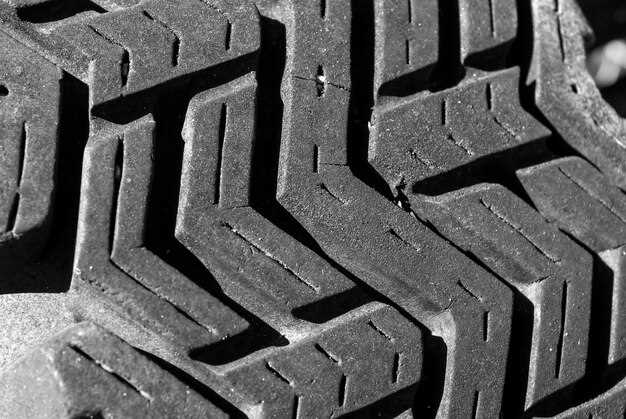For optimal grip on the track, select the right tire compound based on the racing conditions. Softer compounds provide better traction in colder weather, while harder compounds excel in higher temperatures. Adjust your tire choice according to your car’s weight and suspension setup for maximum performance.
Understand tire pressure. Maintaining appropriate tire pressure is key to achieving the desired grip. Low pressure can increase tire flex, leading to overheating, while high pressure may reduce the contact patch. Regularly check and adjust tire pressure according to the manufacturer’s specifications and the specific demands of the race.
Monitor tire wear. Keeping an eye on tire wear patterns helps in making informed decisions during a race. Uneven wear can indicate misalignment or suspension issues. Rotate your tires when necessary and replace them at the first sign of significant wear to ensure consistent grip throughout the race.
Consider track conditions. Different surfaces and weather conditions can significantly influence your tire’s performance. For wet tracks, opt for tires designed for optimal drainage and grip. On dry surfaces, slick tires can provide superior contact and handling. Adjust your strategy based on real-time assessments of the track to stay ahead.
By focusing on tire selection, pressure management, wear monitoring, and adapting to track conditions, you will enhance your vehicle’s grip, leading to improved lap times and overall performance on the track.
How Tire Grip Affects Cornering Speed in Racing

Increasing tire grip enhances cornering speed directly. Optimal grip allows drivers to maintain higher speeds while navigating bends. This happens due to the friction between the tire and the track surface, which provides the necessary force to keep the vehicle on its intended path.
Consider tire compounds. Softer compounds typically offer greater grip, allowing for quicker cornering. Drivers can exploit this by strategizing tire choices according to race conditions. For instance, wet weather requires tires designed for maximum water displacement and grip, while dry conditions favor harder compounds for durability.
Another factor is tire pressure. Adjusting tire pressure affects the contact patch–the area where the tire meets the road. A larger contact patch can increase grip, translating to better cornering performance. However, excessive pressure can reduce the contact area and grip, leading to slower cornering speeds.
Camber angle also plays a significant role. Negative camber means that the top of the tire leans inward. This configuration enhances grip during cornering by maximizing the contact area. Fine-tuning camber settings can yield noticeable improvements in cornering speeds.
A vehicle’s weight distribution impacts tire grip as well. Proper balance between the front and rear tires ensures that all tires maintain optimal contact with the track during cornering. Adjusting weight distribution through setup changes can significantly affect cornering dynamics and speeds.
Lastly, track conditions cannot be overlooked. Surfaces vary widely, from asphalt to concrete, each offering different grip levels. Familiarity with specific track characteristics allows drivers to adapt their strategies accordingly, optimizing their cornering speed throughout the race.
Exploring the Role of Tire Compounds in Different Weather Conditions

Choosing the right tire compound for specific weather conditions enhances grip and improves performance. Here’s a breakdown of how different compounds affect traction under various circumstances.
- Dry Conditions:
- Use soft compounds for maximum grip. These tires heat up quickly and provide superior traction.
- Medium compounds offer a balance between durability and performance, suitable for varied track conditions.
- Hard compounds should be avoided unless conditions are extremely hot, as they may lack the necessary grip.
- Wet Conditions:
- Select wet-weather tires with specialized grooves for channeling water away, enhancing grip on slippery surfaces.
- Intermediate compounds provide versatility when transitioning between dry and wet conditions.
- Avoid using dry tires on wet surfaces, as the reduced contact area can lead to hydroplaning.
- Cold Weather:
- Opt for tires designed for low temperatures. These compounds stay pliable, allowing better grip on cold asphalt.
- Winter tires come with additional features, such as studs, for improved traction on snow and ice.
- Avoid soft summer tires, as they can harden and lose grip in cold conditions.
- Variable Conditions:
- Choose tires that can adapt to changing conditions, such as all-season compounds that provide moderate performance.
- Pay attention to the forecast and switch between compounds as conditions shift to maximize performance.
Selecting the correct tire compound is key to achieving optimal performance in diverse weather conditions. Keep these guidelines in mind to ensure safety and enhance your racing experience.
Impact of Tire Pressure on Vehicle Handling and Stability

Maintaining the correct tire pressure optimizes vehicle handling and enhances stability during driving. For performance vehicles, a pressure between 30-34 psi often yields the best grip and responsiveness. Lower pressures can improve traction but may cause excessive sidewall flex, impacting control.
Effects of Over-Inflation
Over-inflated tires can lead to a reduced contact patch, diminishing grip, especially during cornering. This condition increases the risk of losing traction, particularly on wet surfaces. Drivers should regularly check tire pressure, as ambient temperature changes can affect readings; a drop of 1 psi occurs for every 10-degree Fahrenheit decrease in temperature.
Benefits of Correct Pressure
Maintaining optimal tire pressure promotes even tire wear, improving lifespan. Regular pressure checks ensure that tires perform effectively, providing better fuel efficiency and smoother rides. A simple investment in a reliable pressure gauge and routine checks can significantly enhance driving performance.
Understanding the Construction and Design of Racing Tires
Choose a racing tire with a multi-layer construction that enhances performance under extreme conditions. The outer layer, typically made of high-performance rubber compounds, provides maximum grip on various surfaces. Look for a tread pattern optimized for specific track conditions; slick tires excel on dry asphalt, while tires with grooves perform better on wet surfaces.
The sidewall design greatly influences handling and responsiveness. A stiffer sidewall reduces flex during cornering, resulting in improved stability. Conversely, a more flexible design can enhance traction during acceleration. Balance these attributes based on your racing style and track requirements.
Pay attention to tire compounds. Softer compounds deliver superior grip but wear out faster, while harder compounds offer longevity at the expense of traction. Assess the trade-offs based on race duration and expected conditions.
Consider tire temperature management. An optimal operating temperature increases grip; racing tires often have built-in indicators to help monitor this. Utilize tire warmers for optimal performance right from the start.
| Tire Component | Function | Recommendation |
|---|---|---|
| Outer Layer | Maximizes grip | Choose high-performance rubber |
| Tread Pattern | Optimizes traction on surface | Select based on track conditions |
| Sidewall Design | Affects handling and responsiveness | Adjust stiffness according to race style |
| Tire Compound | Balances grip and durability | Match compound to race length and conditions |
| Temperature Indicators | Helps monitor optimal grip conditions | Use tire warmers to achieve ideal temps |
Regularly inspect tires for wear and damage. Replace them as needed to maintain performance and safety. Understanding these elements leads to the right choice in racing tires, ensuring optimal grip and handling on the track.
Analyzing the Relationship Between Tire Wear and Lap Times
Tire wear directly influences lap times; as tires degrade, performance declines. Monitor tire wear closely and adjust driving styles to maintain speed. For the best results, measure tire grip loss regularly to prevent sudden decreases in lap performance.
Quantifying Wear Impact
Quantify tire wear by analyzing lap time data over extended runs. Compare initial lap times with those from subsequent laps. A modest pace can still yield consistent lap times, whereas noticeable wear often leads to significant time losses. Aim for tire temperatures in the optimal range, as mismanagement can accelerate wear and impact grip.
Strategies for Optimization
To optimize performance, adjust tire pressure based on wear observations. Lower pressure can enhance grip in initial laps but may lead to faster wear. Monitor tire degradation patterns to plan pit stops efficiently–change tires before performance drop becomes critical. Consider employing data analytics tools to accumulate wear and lap time statistics for a strategic edge during races.
How Different Racing Disciplines Influence Tire Selection
Racing disciplines dictate specific tire characteristics. For example, Formula 1 prioritizes high grip on smooth asphalt, leading to the use of soft compounds. These tires, like the Pirelli Supersoft, maximize performance on dry tracks, allowing drivers to navigate corners with precision.
Endurance Racing
In endurance racing, such as the 24 Hours of Le Mans, durability takes precedence. Teams select tires designed for longevity and consistent performance. Michelin’s endurance tires feature a robust construction to withstand long stints and varied weather conditions, ensuring reliability over time.
Rally Racing
Rally tires, like those from Dunlop and Michelin, focus on versatility and grip across diverse surfaces. Off-road capabilities are vital, so tread patterns adapt to gravel, mud, or snow. Options like the soft compound for sticky conditions or hard compound for dry routes provide drivers with necessary choices based on changing terrains.
Each racing discipline commands unique tire specifications, ensuring optimal grip and performance tailored to the track or environment. Selecting the right tires will always be a key factor in achieving competitive advantages in different racing formats.
Evaluating Safety Standards for High-Performance Racing Tires
Inspect performance ratings carefully. Always choose tires that comply with established safety standards such as DOT, ECE, or FIA regulations. These classifications confirm that tires underwent rigorous testing for durability and performance under extreme conditions.
Prioritize tires with high traction and temperature resistance ratings. A tire’s grip significantly impacts handling and stability, particularly in high-speed scenarios. Check for the tire’s tread pattern and compound, as these features significantly influence performance on various surfaces.
Look for tires featuring advanced technologies like run-flat systems, which allow continued travel after a puncture. This feature enhances safety by reducing the risk of losing control due to sudden air loss.
Consider the sidewall strength; reinforced sidewalls provide extra support during cornering, reducing the likelihood of tire failure. Testing methods like the load index and speed rating offer insights into the tire’s ability to handle stress at high speeds.
Pay attention to the manufacturer’s history in producing racing tires. A reputable brand often reflects a commitment to safety, innovation, and performance. Research customer reviews and expert opinions to gauge tire reliability over time.
Regular maintenance and inspections also play a critical role. Monitor tire pressure and tread wear consistently to ensure optimal performance and safety. Adhering to maintenance recommendations contributes to the longevity and effectiveness of racing tires.
Always ensure the tire chosen fits the specific requirements of your racing conditions. Different tracks and weather conditions may demand specialized tires, so assess your environment before making a decision.
Strategies for Optimizing Tire Performance During Races
Choose the right tire compound for the track surface. Soft compounds provide maximum grip but wear out quickly, while hard compounds last longer but offer less traction. Assess the track conditions and temperature before making your selection.
Adjust tire pressure consistently. Higher pressures reduce rolling resistance but can decrease grip, while lower pressures increase contact patch for better traction. Test different pressures during practice sessions to find the optimal balance for your setup.
- Monitor tire temperatures using pyrometers. Aim for the optimal operating range to ensure maximum grip and longevity.
- Use tire blankets to preheat tires before the race. This helps achieve optimal temperature faster, enhancing performance during the initial laps.
Implement a proper alignment setup. Ensure that camber, toe, and caster angles are set according to your tire and suspension characteristics. This maximizes the contact patch, improving grip during cornering.
- Maintain a consistent driving style. Smooth inputs on the throttle, brakes, and steering help prevent unnecessary tire scrubbing and wear.
- Plan pit stops strategically. Replace tires when they begin to lose performance based on telemetry data rather than a set schedule.
Keep tire wear patterns in mind. Regularly check for signs of uneven wear, which can indicate issues with suspension settings or driving style. Address these problems promptly to ensure tire performance remains optimal throughout the race.
Communicate with your team during the race. Discuss tire performance and listen to feedback from your spotter or crew regarding grip levels and handling. Adjust your driving accordingly to maintain pace.
Lastly, practice race scenarios during testing. Simulate long stints to understand tire degradation and adjust strategies proactively. This preparation lays the groundwork for better decision-making during actual races.
Video:
Why Do Wider Tires Have More Grip? Tire Load Sensitivity
Why Do Wider Tires Have More Grip? Tire Load Sensitivity by Engineering Explained 176,883 views 10 years ago 6 minutes, 29 seconds
Q&A:
What factors contribute to the grip of racing tires?
The grip of racing tires is influenced by several key factors, including the tire compound, tread pattern, temperature, and surface of the track. Softer compounds tend to provide more grip as they can conform better to the track surface. The tread pattern also plays a role, with certain designs enhancing grip in specific conditions, such as wet or dry pavement. Additionally, tire temperature is critical; tires perform best when they are warmed up to their optimal operating temperature, which can vary based on the material used and the conditions on the track.
How do tire pressures affect grip during racing?
Tire pressure is a significant factor in determining grip. If the pressure is too low, the tire may deform excessively, leading to increased rolling resistance and reduced grip. Conversely, too high a pressure can result in a smaller contact patch with the road, compromising traction. Finding the right balance is crucial, as temperature changes during a race can affect tire pressure and performance. Teams often adjust tire pressures based on track conditions and weather to optimize grip throughout the race.
Why do racing tires wear differently compared to regular tires?
Racing tires are designed specifically for performance, often using softer compounds that provide maximum grip but wear out more quickly. Unlike regular tires, which prioritize longevity and efficiency, racing tires sacrifice durability for superior traction and cornering capabilities. The construction and tread patterns are also optimized for high-speed performance and handling. As a result, racing tires can wear down dramatically over a single race, requiring teams to manage tire strategy closely and potentially switch tires multiple times during a race to maintain optimal performance.
What role does tire temperature play in a race?
Tire temperature significantly influences performance, as it affects grip and handling characteristics. Tires have an optimal temperature range where they provide the best traction and responsiveness. If the tires are too cold, they may not grip the track effectively, leading to poor handling. On the other hand, overheating can cause tires to lose grip and become less effective. Drivers and teams monitor tire temperatures constantly and make adjustments, such as altering driving style or tire pressures, to ensure tires remain within the ideal range throughout the race.
How do different racing disciplines affect tire choice?
Different racing disciplines have unique requirements that influence tire choice. For example, Formula 1 cars use specialized tires designed for high-speed tracks, optimized for minimal rolling resistance and maximum grip. In contrast, off-road racing uses tires with a more aggressive tread pattern to handle rough terrains and provide traction on uneven surfaces. Endurance racing may prioritize longevity, leading to different compounds that offer a balance between grip and durability. As such, teams must carefully select tires based on the specific demands of the racing environment to achieve the best performance.


